Samosa Tutorial
Sorry for the long delay, but as promised, here's a new tutorial. I'll try posting about the chutney soon. I think I may try a more macrobiotic-friendly version of samosas soon, but until then, here's a vegan version.
Samosas with Pomegranate Cilantro Chutney and condiments

Samosas
Christina Terriquez
For crust:
1 cup organic white wheat flour
2 teaspoons organic safflower oil
1/4 teaspoon unrefined sea salt
1/3--3/4 cups water
1-3 cups of organic safflower oil, rice bran oil, or sunflower oil for frying
Filling:
1 teaspoon organic olive oil
1 tablespoon (or to taste) curry powder or a mixture of your favorite Indian spices such as:
coriander, tumeric, ground clove, ginger powder, cumin, chili powder, etc.
1/4 cup organic onion, diced (optional)
1 inch fresh ginger, peeled and minced (optional)
1--2 cloves organic garlic, minced (optional)
3 medium organic potatoes, boiled until soft and slightly mashed
1/2--1 cup organic frozen peas, thawed
unrefined sea salt
1/4--1/2 cup organic toasted slivered almonds (optional)
1/4--1/2 cup organic currants, raisins or sultanas (optional)
To prepare dough:
Shift flour and salt into a medium sized bowl. Add oil and mix until texture resembles a fine sand. Add 1/3 cup water and mix until flour comes together as a ball. More water may be needed. I usually use 1/2 cup. Knead dough for about 5 minutes, until dough is smooth and soft. Set aside and let dough rest for about 15 minutes.
To prepare filling:
Heat oil in a stainless steel or cast iron skillet (oil should never smoke). Add dried spices and sauté over medium heat for 45 seconds to two minutes, until spices turn slightly darker and become fragrant. Add onion, garlic, and ginger and sauté until onion becomes translucent. Add potatoes and stir well. When all spices are evenly incorporated throughout the potatoes, add the peas, almonds and dried fruit, if using it. Remove from heat and set aside.
Prepared samosa filling with almonds and currants

To roll out dough and fill samosas:
Knead the dough for about two minutes.
Set up your workspace with an area (countertop or cutting board) large enough to roll the dough out, a small cup of water (1/2 cup) for dipping your fingers, a small amount of flour (less than 1/2 cup) for dusting your board, a bowl with the prepare filling and a small spoon, and two platters, plates or cookie sheets, one lined with parchment paper or a covered with a floursack towel and the other lined with paper towels.
Lightly flour your rolling area. Use just enough flour so that your dough will not stick, but not so much that thedough is completely caked in flour, either. Cut off a golf-ball-sized piece of dough, and roll it out into a large circle, approximately 6-8 inches in diameter. Cut the circle in half.
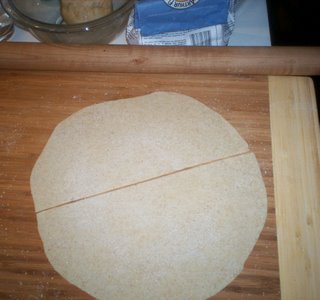
Fold one half circle in half.

Wet the top rounded edge of the quarter circle, then fold the bottom rounded edge over and gently press, so that you have a hollow cone.
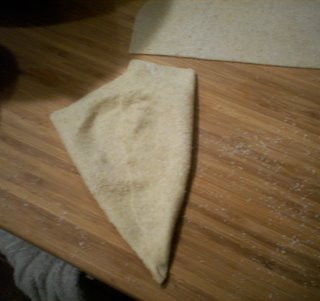
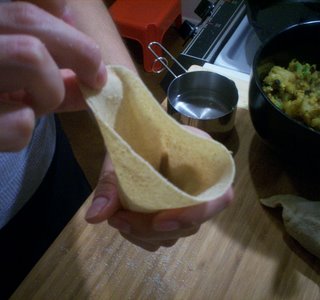
Being careful not to tear the dough, use the small spoon to gently fill the cone 3/4 of the way full.
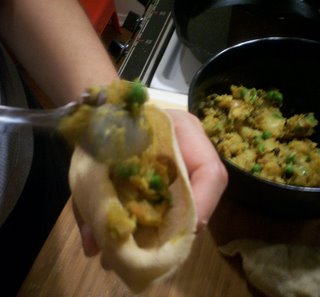


Once the cone is 3/4 of the way full, lay one half of the unfilled portion of the cone down over the filling.
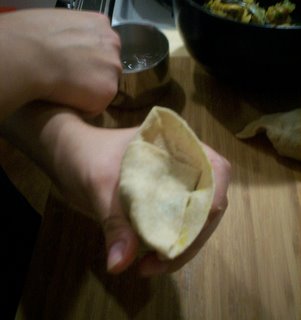
Next, wet the free-standing edge and gently fold and press it over the samosa.
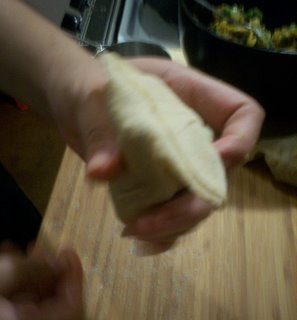
Gently heat the organic safflower oil, rice bran oil, or sunflower oil. I used about 1 cup in an 8 inch cast iron pan, but if you have a tempura pan or something similar, use it, and fill with about 1 inch of oil. Oil is hot enough when a wooden chopstick inserted into the oil bubbles, or alternately, when a small, dry piece of dough is dropped in the oil and it bobs up to the surface almost immediately. Be careful to make sure oil does not smoke.
When oil is hot, gently place a few samosas in pan being careful not to overcrowd pan. Samosas will need to be turned at least once. If samosas are especially full, they may have three sides to brown. When a samosa is brown on all sides, remove it and let it drain on paper towels. I use cooking chopsticks for this as they give me more control and make less of a mess than skimmers.
Serve samosas warm. Especially delicious with chutney.
Samosas filled with curried potatoes, peas, almonds and currants.

Notes:
You may use unbleached white flour or regular whole wheat (or even spelt flour), but I've found that the color and texture are best when I use white wheat flour. White wheat flour is a whole wheat flour that is made from a lighter variety of wheat, so it is lighter in color and softer, but still contains the bran, which gives it more texture and nutritional value than white flour (which contains no bran). It's kind of like the difference between white rice and brown rice. Neither whole wheat flour nor white wheat flour are really whole grains, though. Flours, by definition, cannot be whole grains as they have been ground. I have not tried to make any gluten-free samosas, but I'm sure garbanzo bean flour would be appropriate as far as taste.
